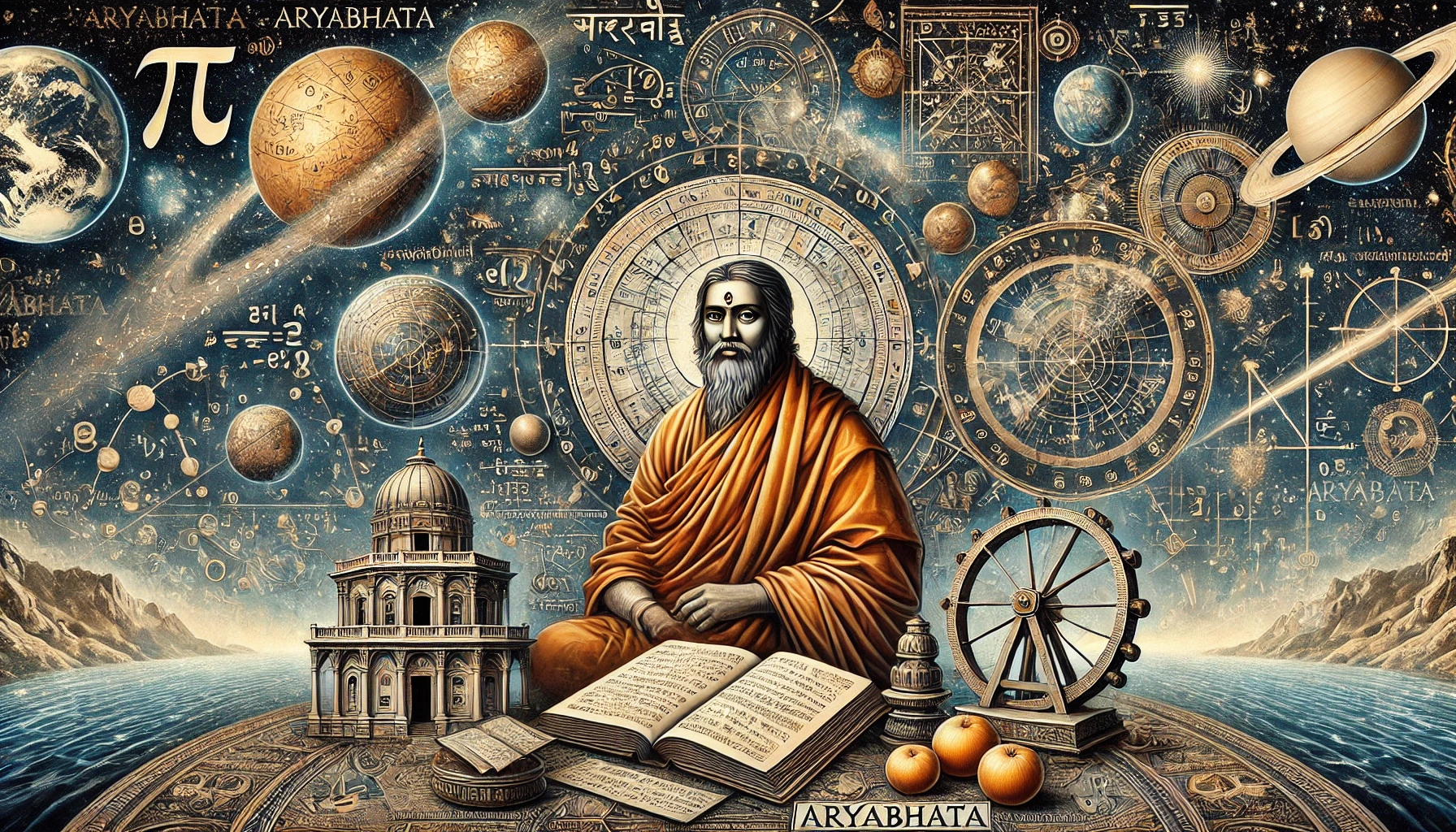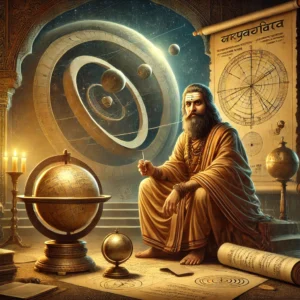
Discoveries of Aryabhata in Space Science
Aryabhata’s Discoveries in Space Science
Aryabhata, one of the most celebrated mathematicians and astronomers of ancient India, was a true pioneer whose contributions to space science were centuries ahead of his time. Born in 476 CE in what is believed to be present-day Bihar, India, Aryabhata’s scientific genius and innovative ideas laid the groundwork for modern astronomy. His monumental work, the Aryabhatiya, written when he was only 23 years old, encapsulated his mathematical and astronomical discoveries and became an enduring legacy in the scientific world.
Aryabhata’s contributions spanned a wide range of topics, from celestial mechanics to mathematical innovations, all of which challenged the prevailing beliefs and set the stage for future advancements in space science.
Revolutionary Concept of Earth’s Rotation
One of Aryabhata’s most significant contributions was his assertion that the Earth rotates on its axis. At a time when the geocentric model, which posited that the Earth was stationary and all celestial bodies revolved around it, dominated global thought, Aryabhata proposed an alternative explanation. He correctly observed that the apparent westward motion of the stars and other celestial bodies was due to the eastward rotation of the Earth.
This idea was groundbreaking because it shifted the perspective from a static Earth-centric universe to a dynamic understanding of planetary motion. Aryabhata’s explanation anticipated the heliocentric theories later formulated by Copernicus and Galileo, making him a precursor to modern astronomy.
Scientific Explanation of Eclipses
Another landmark discovery by Aryabhata was his scientific explanation of eclipses. During his time, eclipses were often attributed to supernatural or mythological forces. Aryabhata debunked these beliefs by correctly explaining the mechanisms behind solar and lunar eclipses.
He demonstrated that a lunar eclipse occurs when the Moon passes through the Earth’s shadow, while a solar eclipse happens when the Moon blocks sunlight from reaching the Earth. He also rejected the belief that eclipses were caused by a celestial demon (Rahu in Indian mythology). Instead, Aryabhata emphasized that these phenomena were natural occurrences governed by predictable laws of celestial motion. His insights were remarkably accurate, considering the lack of advanced observational tools available at the time.
Table of Contents
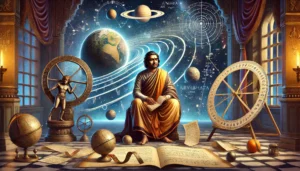
Discoveries of Aryabhata in Space Science
Precise Calculations of Celestial Measurements
Aryabhata’s mathematical brilliance shone through in his calculations of various astronomical measurements. He estimated the circumference of the Earth to be approximately 39,968 kilometers, a value strikingly close to the modern measurement of 40,075 kilometers. This demonstrates his exceptional understanding of geometry and spherical trigonometry.
Additionally, Aryabhata calculated the length of the solar year as 365.358 days, which deviates only slightly from the modern value of 365.256 days. He also provided detailed calculations for the periods of planetary orbits and their movements, showcasing his profound grasp of celestial mechanics.
Reflection of Sunlight and Planetary Motion
Aryabhata was among the first to suggest that the Moon and planets do not emit their own light but reflect sunlight. This observation was revolutionary for his time and contradicted widely held beliefs. Aryabhata also explained that the orbits of planets were elliptical and developed mathematical models to describe their motion, laying the groundwork for the understanding of orbital dynamics.
Mathematical Innovations and Their Role in Astronomy
Aryabhata’s contributions to mathematics were equally groundbreaking. Although he did not invent zero, his use of the decimal place-value system played a critical role in the development of numerical calculations. This system allowed for more accurate astronomical computations, which Aryabhata used to create detailed models of celestial phenomena.
In addition to his work with numbers, Aryabhata introduced trigonometric functions such as sine and cosine, which he used to solve complex astronomical problems. His methods of interpolation and the use of algebraic equations further demonstrated his ingenuity and provided tools for future scientists to refine their models.
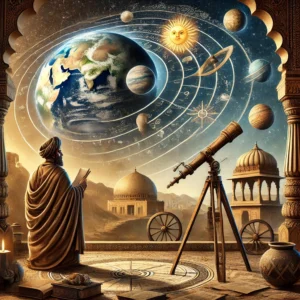
Discoveries of Aryabhata in Space Science
Astronomical Tables and Prediction of Celestial Events
Aryabhata compiled detailed astronomical tables that allowed him to predict celestial events, such as eclipses, with remarkable accuracy. These tables were widely used by scholars in India and beyond. His methods of calculation and prediction were so precise that they were later adopted and refined by Islamic and European astronomers, spreading Aryabhata’s influence across the globe.
Aryabhata’s Influence on Future Generations
The legacy of Aryabhata’s work extended far beyond his lifetime. His Aryabhatiya was translated into Arabic during the Islamic Golden Age, where it inspired many notable scholars, including Al-Khwarizmi, the father of algebra. Aryabhata’s methods and discoveries continued to shape the fields of astronomy and mathematics for centuries, influencing luminaries such as Bhaskara I, Varahamihira, and Brahmagupta in India, as well as scientists in the Middle East and Europe.
Criticism and Challenges
Despite his revolutionary contributions, Aryabhata’s theories faced skepticism from traditionalists during his time. The geocentric view of the universe, rooted in religious and cultural beliefs, continued to dominate for centuries. Aryabhata’s heliocentric hints and his assertion of Earth’s rotation were not fully accepted until much later, when modern observational tools confirmed his ideas.
Modern Recognition
Aryabhata’s contributions are celebrated as a cornerstone of India’s scientific heritage. In 1975, India launched its first satellite, aptly named “Aryabhata,” in honor of the ancient scientist. This milestone symbolized India’s continued commitment to space exploration and scientific advancement, a legacy that Aryabhata helped establish over 1,500 years ago.
Conclusion
Aryabhata’s discoveries in space science and mathematics were a testament to his extraordinary intellect and curiosity. His insights into Earth’s rotation, eclipses, planetary motion, and celestial measurements were far ahead of his time and have left an indelible mark on the history of science. Aryabhata not only transformed ancient astronomy but also inspired generations of scientists and mathematicians around the world. His work continues to be a source of pride and inspiration, reminding us of the power of human ingenuity and the timeless pursuit of knowledge.
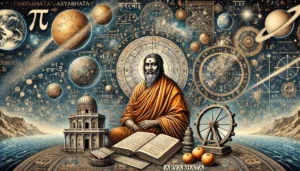
Discoveries of Aryabhata in Space Science
FAQs on Aryabhata’s Revolutionary Contributions to Space Science
1. Who was Aryabhata?
Aryabhata was an ancient Indian mathematician and astronomer who lived around 476–550 CE. He is regarded as one of the greatest scientific minds of ancient India. His work in mathematics and astronomy was groundbreaking, forming the basis for many modern principles of space science.
2. What were Aryabhata’s key contributions to space science?
Aryabhata made several significant contributions, including:
Proposing that the Earth rotates on its axis, explaining the apparent movement of the stars.
Calculating the Earth’s circumference with remarkable accuracy.
Developing a heliocentric model suggesting that planets revolve around the Sun.
Explaining the scientific reasons behind solar and lunar eclipses.
Accurately estimating the duration of a year and the length of a day.
3. How did Aryabhata revolutionize the understanding of eclipses?
Aryabhata debunked myths and superstition surrounding eclipses. He scientifically explained that a lunar eclipse occurs when the Moon passes into the Earth’s shadow, and a solar eclipse occurs when the Moon comes between the Earth and the Sun. He also rejected the belief that eclipses were caused by mythical entities like Rahu and Ketu.
4. How precise were Aryabhata’s calculations of the Earth’s size and the length of a year?
Aryabhata estimated the Earth’s circumference to be 39,968 kilometers, which is very close to the modern measurement of 40,075 kilometers. He also calculated the length of a year to be approximately 365.258 days, which aligns closely with today’s value of 365.256 days.
5. What mathematical concepts did Aryabhata develop for space science?
Aryabhata introduced many mathematical concepts that are crucial for space science, such as:
Trigonometric functions like sine, cosine, and their tabular values.
Algebraic solutions for astronomical calculations.
Methods for calculating the positions of celestial bodies.
His sine table, known as “Ardha-jya,” was especially revolutionary for its application in astronomical measurements.
6. What was Aryabhata’s view on the geocentric model of the universe?
Aryabhata challenged the prevailing geocentric view of the universe (Earth being the center). He proposed a heliocentric model where planets revolve around the Sun, though his ideas were not widely accepted at the time.
7. What is Aryabhatiya, and why is it important?
Aryabhatiya is Aryabhata’s seminal text, written in Sanskrit. It is a comprehensive treatise on mathematics and astronomy, covering topics such as arithmetic, algebra, trigonometry, planetary motion, and eclipses. It was highly influential and translated into several languages, spreading his ideas across cultures.
8. Did Aryabhata influence other cultures and scientists?
Yes, Aryabhata’s work greatly influenced Arab and Islamic scholars during the Islamic Golden Age. His texts were translated into Arabic, where his ideas shaped the development of astronomy in the Middle East. These contributions eventually reached Europe, influencing the Renaissance and modern scientific thought.
9. How is Aryabhata’s legacy celebrated today?
Aryabhata’s legacy is celebrated in multiple ways:
India named its first satellite, Aryabhata, launched in 1975, in his honor.
Numerous institutions, awards, and scientific events are named after him.
His work continues to be studied as a foundation of ancient scientific thought.
10. How did Aryabhata explain the movement of celestial bodies?
Aryabhata proposed that the Earth rotates on its axis, causing the apparent motion of celestial bodies like the Sun and stars. He also provided calculations for the motion of planets and their orbits, which were revolutionary for his time.
11. Was Aryabhata the first to propose the Earth’s rotation?
Yes, Aryabhata was one of the earliest known scientists to propose the concept of the Earth’s axial rotation. His explanation predates similar ideas proposed in the Western world by centuries.
12. How did Aryabhata’s work influence modern space science?
Aryabhata’s emphasis on observation, precise calculations, and logical reasoning laid the groundwork for modern space science. His methodologies continue to inspire astronomers and mathematicians, and his work is seen as a precursor to contemporary celestial mechanics.
13. What challenges did Aryabhata face in his time?
Aryabhata lived in an era dominated by mythological and religious explanations for natural phenomena. Despite this, he championed scientific reasoning and empirical observations, challenging deeply rooted superstitions and laying the foundation for scientific inquiry in ancient India.
14. What tools did Aryabhata use for his astronomical studies?
Aryabhata relied on mathematical calculations and geometric models rather than physical instruments. His mastery of trigonometry and algebra allowed him to make precise predictions about celestial events, planetary motion, and eclipses.
15. Why is Aryabhata considered a pioneer in space science?
Aryabhata is considered a pioneer because he introduced a scientific and mathematical framework for understanding the universe. His accurate predictions, revolutionary theories, and logical explanations paved the way for future advancements in astronomy and space exploration.
16. What modern fields of science can trace their roots to Aryabhata’s work?
Aryabhata’s contributions are foundational to:
Astronomy and astrophysics.
Space exploration and celestial mechanics.
Mathematics, including algebra, trigonometry, and calculus.
His interdisciplinary approach continues to inspire research in both pure and applied sciences.
17. What makes Aryabhata’s contributions timeless?
Aryabhata’s work was ahead of his time, providing insights and methods that remain relevant even today. His ability to combine logic, observation, and mathematics to explain complex phenomena makes his contributions timeless and globally influential.
18. What is Aryabhata’s influence on India’s space program?
Aryabhata’s legacy is deeply intertwined with India’s space program. The Indian Space Research Organisation (ISRO) named its first satellite after him, symbolizing his pioneering spirit and India’s commitment to scientific innovation in space exploration.
By bridging ancient wisdom and modern science, Aryabhata’s contributions remain a testament to the enduring power of knowledge and discovery.
Summary
“Aryabhata’s Revolutionary Contributions to Space Science” highlights the pioneering work of the ancient Indian mathematician and astronomer, Aryabhata, in the field of space science. Aryabhata’s most notable contributions include his accurate calculation of the Earth’s rotation on its axis, which he estimated to be approximately 23 hours and 56 minutes, a discovery that foreshadowed modern understanding of the day-night cycle. He also proposed that the Earth orbits the Sun, which contradicted the prevailing belief that the Sun orbited the Earth.
In his treatise Aryabhatiya, Aryabhata introduced the concept of zero and place value, which laid the foundation for modern mathematics. He also accurately described the Moon’s reflection of sunlight and explained lunar eclipses as the result of the Moon passing into Earth’s shadow. Aryabhata’s work on the calculation of the Earth’s circumference, his methods for predicting celestial events, and his contributions to the understanding of planetary motion significantly advanced space science long before the advent of modern telescopes and space exploration. His insights remain influential in the development of astronomy and mathematics today.
Related Articles
- Restful Nights: Ayurvedic Remedies and Traditional Indian Practices to Overcome Insomnia and Late-Night Habits
- The Tridevi: Lakshmi, Saraswati, and Parvati – Their Roles and Powers
- “Divine Creatures of Ancient Indian Scriptures: Exploring the Role of Animals in the Vedas, Puranas, and Mahabharata”
- Nature and Spirituality: Exploring the Sacred Essence of the Himalayas, Ganga, and Other Natural Wonders”
- “Reviving the Gurukul System: Relevance and Lessons for Modern Education”
- “Exploring Greek and Indian Mythology: Similarities Between Greek and Indian Mythology “
- “Embracing Sattvic Living: Harmonizing Mind, Body, and Soul Through Food and Lifestyle”
- “Charity and Prosperity: Exploring the Concept of Daan and Its Financial Relevance in Modern Life”
- How to Build an Eco-Friendly Home Inspired by Vastu Shastra
- Comparison of Ancient and Modern Sports: How Traditional Sports Have Influenced Contemporary Games
- “Timeless Lessons from Ancient Tales: Linking Samudra Manthan and Ganga’s Descent to Modern Ecological Challenges”
- “Reviving Sanskrit: How AI is Preserving Ancient Languages for the Future”
- “Mathura: The Sacred Land of Lord Krishna’s Divine Leelas”
- Investing for Future Generations: Lessons from Indian Traditions on Legacy Building and Wealth Preservation
- “Ancient Indian Wisdom: Timeless Lessons for Tackling Today’s Climate Crisis”
- “Artificial Intelligence and Spirituality: Transforming Ancient Practices for the Modern World”
- “Gold and Real Estate in India: Timeless Assets Shaping Financial Strategies”
- Tradition Meets Innovation: The Evolution of Technology in Hindu Rituals
- End-of-World Myths: Exploring Kali Yuga in Hinduism and Ragnarök in Norse Mythology
- Garuda, Pegasus, and Dragons: The Universal Ties of Mythical Beasts Across Cultures
- “Ancient Vimanas: Mythical Flying Machines or Evidence of Advanced Technology?”
- Time Travel in Hindu Mythology: The Fascinating Tales of Kakudmi and King Raivata
- “Divine Feminine Power in Hindu Mythology: The Legends of Durga, Saraswati, and Lakshmi”
- “Divine Beings of Sanatan Dharma: The Spiritual Significance of Sacred Animals in Hinduism”
- “Symbolism in Mythological Art: Unlocking Hidden Meanings in Ancient Temple Carvings”
- “Exploring Technological Advancements in Ancient India and Civilizations: Vimana, Metallurgy, & Water Management systems”
- Unveiling the Mysteries: Ancient Temples of Sanatan Dharma , Mysterious Temples of India
- “The Scientific Knowledge of Sanatan Dharma: Ancient Wisdom Meets Modern Science”
- Ancient Indian Sports and Games: Celebrating a Legacy of Skill, Strength & Strategy”
- “Exploring the Cosmic Link: The Connection Between Astronomy and Vedic Astrology”
- The Power of Sanskrit: Unlocking the Divine Language of the Gods
- “The End of Kaliyuga: A Sanatan Insight into the World’s Final Chapter”
- Explore more articles on Prachin Sanatan Yuga.
Discoveries of Aryabhata in Space Science Discoveries of Aryabhata in Space Science Discoveries of Aryabhata in Space Science Discoveries of Aryabhata in Space Science Discoveries of Aryabhata in Space Science Discoveries of Aryabhata in Space Science Discoveries of Aryabhata in Space Science Discoveries of Aryabhata in Space Science Discoveries of Aryabhata in Space Science
Discoveries of Aryabhata in Space Science Discoveries of Aryabhata in Space Science Discoveries of Aryabhata in Space Science Discoveries of Aryabhata in Space Science Discoveries of Aryabhata in Space Science Discoveries of Aryabhata in Space Science Discoveries of Aryabhata in Space Science Discoveries of Aryabhata in Space Science Discoveries of Aryabhata in Space Science
Discoveries of Aryabhata in Space Science Discoveries of Aryabhata in Space Science Discoveries of Aryabhata in Space Science Discoveries of Aryabhata in Space Science Discoveries of Aryabhata in Space Science Discoveries of Aryabhata in Space Science Discoveries of Aryabhata in Space Science Discoveries of Aryabhata in Space Science Discoveries of Aryabhata in Space Science
